The Java® Virtual Machine Specification
Table of Contents
Preface to the Java SE 7 Edition
Preface to the Second Edition
Preface to the First Edition
1. Introduction
1.1. A Bit of History
1.2. The Java Virtual Machine
1.3. Summary of Chapters
1.4. Notation
2. The Structure of the Java Virtual Machine
2.1. The class File Format
2.2. Data Types
2.3. Primitive Types and Values
2.3.1. Integral Types and Values
2.3.2. Floating-Point Types, Value Sets, and Values
2.3.3. The returnAddress Type and Values
2.3.4. The boolean Type
2.4. Reference Types and Values
2.5. Run-Time Data Areas
2.5.1. The pc Register
2.5.2. Java Virtual Machine Stacks
2.5.3. Heap
2.5.4. Method Area
2.5.5. Run-Time Constant Pool
2.5.6. Native Method Stacks
2.6. Frames
2.6.1. Local Variables
2.6.2. Operand Stacks
2.6.3. Dynamic Linking
2.6.4. Normal Method Invocation Completion
2.6.5. Abrupt Method Invocation Completion
2.7. Representation of Objects
2.8. Floating-Point Arithmetic
2.8.1. Java Virtual Machine Floating-Point Arithmetic and IEEE 754
2.8.2. Floating-Point Modes
2.8.3. Value Set Conversion
2.9. Special Methods
2.10. Exceptions
2.11. Instruction Set Summary
2.11.1. Types and the Java Virtual Machine
2.11.2. Load and Store Instructions
2.11.3. Arithmetic Instructions
2.11.4. Type Conversion Instructions
2.11.5. Object Creation and Manipulation
2.11.6. Operand Stack Management Instructions
2.11.7. Control Transfer Instructions
2.11.8. Method Invocation and Return Instructions
2.11.9. Throwing Exceptions
2.11.10. Synchronization
2.12. Class Libraries
2.13. Public Design, Private Implementation
3. Compiling for the Java Virtual Machine
3.1. Format of Examples
3.2. Use of Constants, Local Variables, and Control Constructs
3.3. Arithmetic
3.4. Accessing the Run-Time Constant Pool
3.5. More Control Examples
3.6. Receiving Arguments
3.7. Invoking Methods
3.8. Working with Class Instances
3.9. Arrays
3.10. Compiling Switches
3.11. Operations on the Operand Stack
3.12. Throwing and Handling Exceptions
3.13. Compiling finally
3.14. Synchronization
3.15. Annotations
4. The class File Format
4.1. The ClassFile Structure
4.2. The Internal Form of Names
4.2.1. Binary Class and Interface Names
4.2.2. Unqualified Names
4.3. Descriptors and Signatures
4.3.1. Grammar Notation
4.3.2. Field Descriptors
4.3.3. Method Descriptors
4.3.4. Signatures
4.4. The Constant Pool
4.4.1. The CONSTANT_Class_info Structure
4.4.2. The CONSTANT_Fieldref_info, CONSTANT_Methodref_info, and CONSTANT_InterfaceMethodref_info Structures
4.4.3. The CONSTANT_String_info Structure
4.4.4. The CONSTANT_Integer_info and CONSTANT_Float_info Structures
4.4.5. The CONSTANT_Long_info and CONSTANT_Double_info Structures
4.4.6. The CONSTANT_NameAndType_info Structure
4.4.7. The CONSTANT_Utf8_info Structure
4.4.8. The CONSTANT_MethodHandle_info Structure
4.4.9. The CONSTANT_MethodType_info Structure
4.4.10. The CONSTANT_InvokeDynamic_info Structure
4.5. Fields
4.6. Methods
4.7. Attributes
4.7.1. Defining and Naming New Attributes
4.7.2. The ConstantValue Attribute
4.7.3. The Code Attribute
4.7.4. The StackMapTable Attribute
4.7.5. The Exceptions Attribute
4.7.6. The InnerClasses Attribute
4.7.7. The EnclosingMethod Attribute
4.7.8. The Synthetic Attribute
4.7.9. The Signature Attribute
4.7.10. The SourceFile Attribute
4.7.11. The SourceDebugExtension Attribute
4.7.12. The LineNumberTable Attribute
4.7.13. The LocalVariableTable Attribute
4.7.14. The LocalVariableTypeTable Attribute
4.7.15. The Deprecated Attribute
4.7.16. The RuntimeVisibleAnnotations attribute
4.7.16.1. The element_value structure
4.7.17. The RuntimeInvisibleAnnotations attribute
4.7.18. The RuntimeVisibleParameterAnnotations attribute
4.7.19. The RuntimeInvisibleParameterAnnotations attribute
4.7.20. The AnnotationDefault attribute
4.7.21. The BootstrapMethods attribute
4.8. Format Checking
4.9. Constraints on Java Virtual Machine code
4.9.1. Static Constraints
4.9.2. Structural Constraints
4.10. Verification of class Files
4.10.1. Verification by Type Checking
4.10.1.1. Accessors for Java Virtual Machine Artifacts
4.10.1.2. Verification Type System
4.10.1.3. Instruction Representation
4.10.1.4. Stack Map Frame Representation
4.10.1.5. Type Checking Abstract and Native Methods
4.10.1.6. Type Checking Methods with Code
4.10.1.7. Type Checking Load and Store Instructions
4.10.1.8. Type Checking for protected Members
4.10.1.9. Type Checking Instructions
aaload
aastore
aconst_null
aload
aload_
anewarray
areturn
arraylength
astore
astore_
athrow
baload
bastore
bipush
caload
castore
checkcast
d2f
d2i
d2l
dadd
daload
dastore
dcmp
dconst_
ddiv
dload
dload_
dmul
dneg
drem
dreturn
dstore
dstore_
dsub
dup
dup_x1
dup_x2
dup2
dup2_x1
dup2_x2
f2d
f2i
f2l
fadd
faload
fastore
fcmp
fconst_
fdiv
fload
fload_
fmul
fneg
frem
freturn
fstore
fstore_
fsub
getfield
getstatic
goto
goto_w
i2b
i2c
i2d
i2f
i2l
i2s
iadd
iaload
iand
iastore
if_acmp
if_icmp
if
ifnonnull
ifnull
iinc
iload
iload_
imul
ineg
instanceof
invokedynamic
invokeinterface
invokespecial
invokestatic
invokevirtual
ior
irem
ireturn
ishl
ishr
istore
istore_
isub
iushr
ixor
l2d
l2f
l2i
ladd
laload
land
lastore
lcmp
lconst_
ldc
ldc_w
ldc2_w
ldiv
lload
lload_
lmul
lneg
lookupswitch
lor
lrem
lreturn
lshl
lshr
lstore
lstore_
lsub
lushr
lxor
monitorenter
monitorexit
multianewarray
new
newarray
nop
pop
pop2
putfield
putstatic
return
saload
sastore
sipush
swap
tableswitch
wide
4.10.2. Verification by Type Inference
4.10.2.1. The Process of Verification by Type Inference
4.10.2.2. The Bytecode Verifier
4.10.2.3. Values of Types long and double
4.10.2.4. Instance Initialization Methods and Newly Created Objects
4.10.2.5. Exceptions and finally
4.11. Limitations of the Java Virtual Machine
5. Loading, Linking, and Initializing
5.1. The Run-Time Constant Pool
5.2. Java Virtual Machine Startup
5.3. Creation and Loading
5.3.1. Loading Using the Bootstrap Class Loader
5.3.2. Loading Using a User-defined Class Loader
5.3.3. Creating Array Classes
5.3.4. Loading Constraints
5.3.5. Deriving a Class from a class File Representation
5.4. Linking
5.4.1. Verification
5.4.2. Preparation
5.4.3. Resolution
5.4.3.1. Class and Interface Resolution
5.4.3.2. Field Resolution
5.4.3.3. Method Resolution
5.4.3.4. Interface Method Resolution
5.4.3.5. Method Type and Method Handle Resolution
5.4.3.6. Call Site Specifier Resolution
5.4.4. Access Control
5.4.5. Method overriding
5.5. Initialization
5.6. Binding Native Method Implementations
5.7. Java Virtual Machine Exit
6. The Java Virtual Machine Instruction Set
6.1. Assumptions: The Meaning of "Must"
6.2. Reserved Opcodes
6.3. Virtual Machine Errors
6.4. Format of Instruction Descriptions
mnemonic
6.5. Instructions
aaload
aastore
aconst_null
aload
aload_
anewarray
areturn
arraylength
astore
astore_
athrow
baload
bastore
bipush
caload
castore
checkcast
d2f
d2i
d2l
dadd
daload
dastore
dcmp
dconst_
ddiv
dload
dload_
dmul
dneg
drem
dreturn
dstore
dstore_
dsub
dup
dup_x1
dup_x2
dup2
dup2_x1
dup2_x2
f2d
f2i
f2l
fadd
faload
fastore
fcmp
fconst_
fdiv
fload
fload_
fmul
fneg
frem
freturn
fstore
fstore_
fsub
getfield
getstatic
goto
goto_w
i2b
i2c
i2d
i2f
i2l
i2s
iadd
iaload
iand
iastore
iconst_
idiv
if_acmp
if_icmp
if
ifnonnull
ifnull
iinc
iload
iload_
imul
ineg
instanceof
invokedynamic
invokeinterface
invokespecial
invokestatic
invokevirtual
ior
irem
ireturn
ishl
ishr
istore
istore_
isub
iushr
ixor
jsr
jsr_w
l2d
l2f
l2i
ladd
laload
land
lastore
lcmp
lconst_
ldc
ldc_w
ldc2_w
ldiv
lload
lload_
lmul
lneg
lookupswitch
lor
lrem
lreturn
lshl
lshr
lstore
lstore_
lsub
lushr
lxor
monitorenter
monitorexit
multianewarray
new
newarray
nop
pop
pop2
putfield
putstatic
ret
return
saload
sastore
sipush
swap
tableswitch
wide
7. Opcode Mnemonics by Opcode
Index
A. Limited License Grant
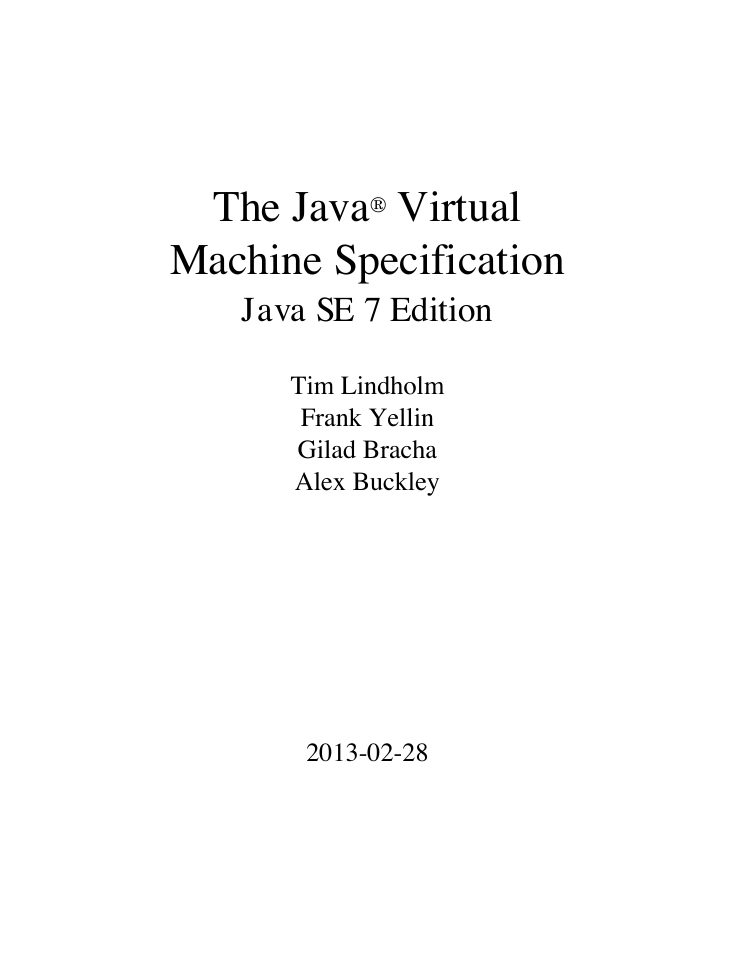
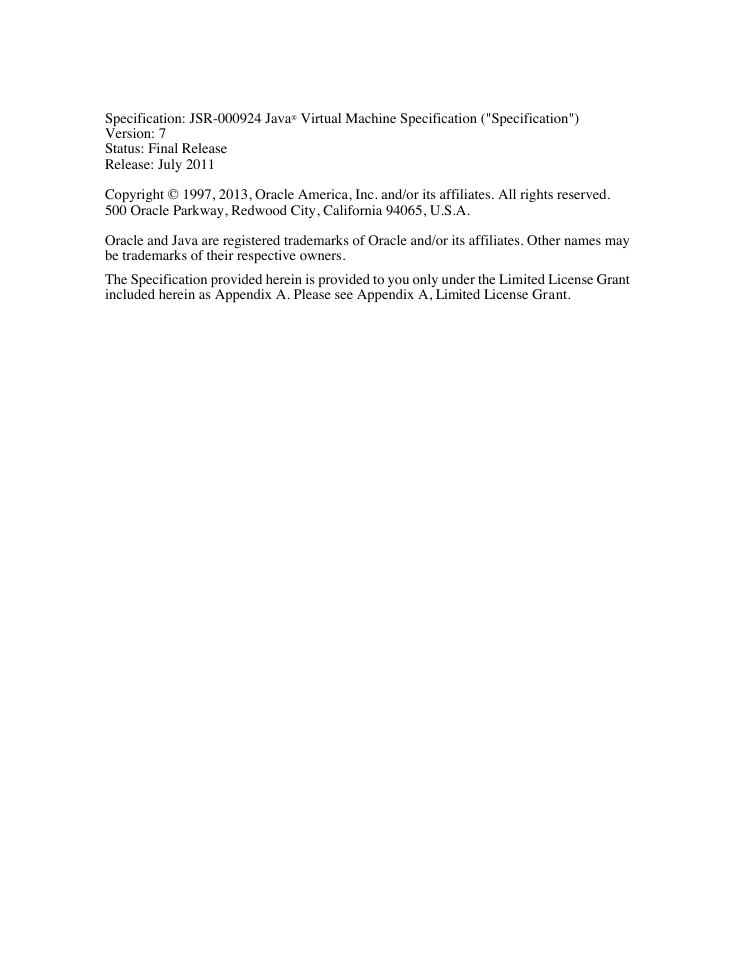
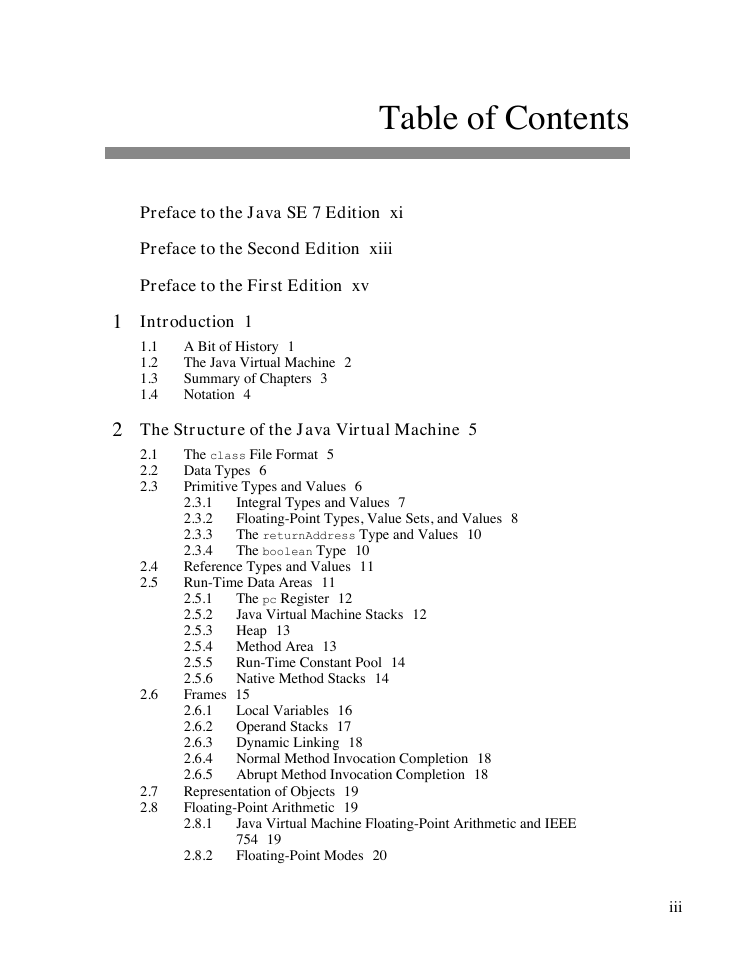

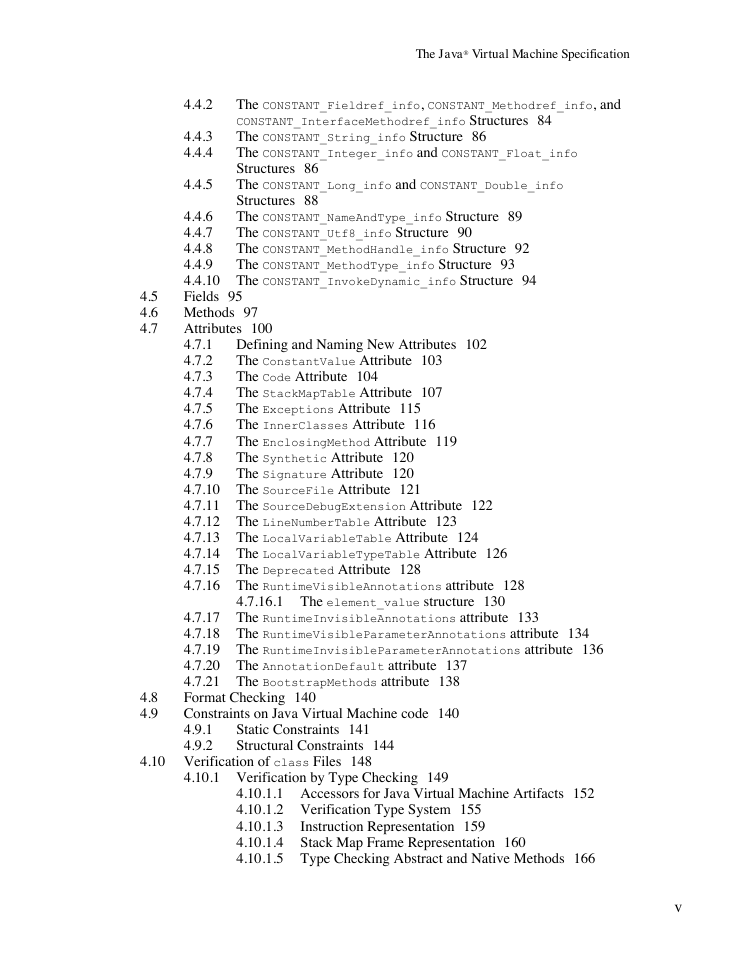
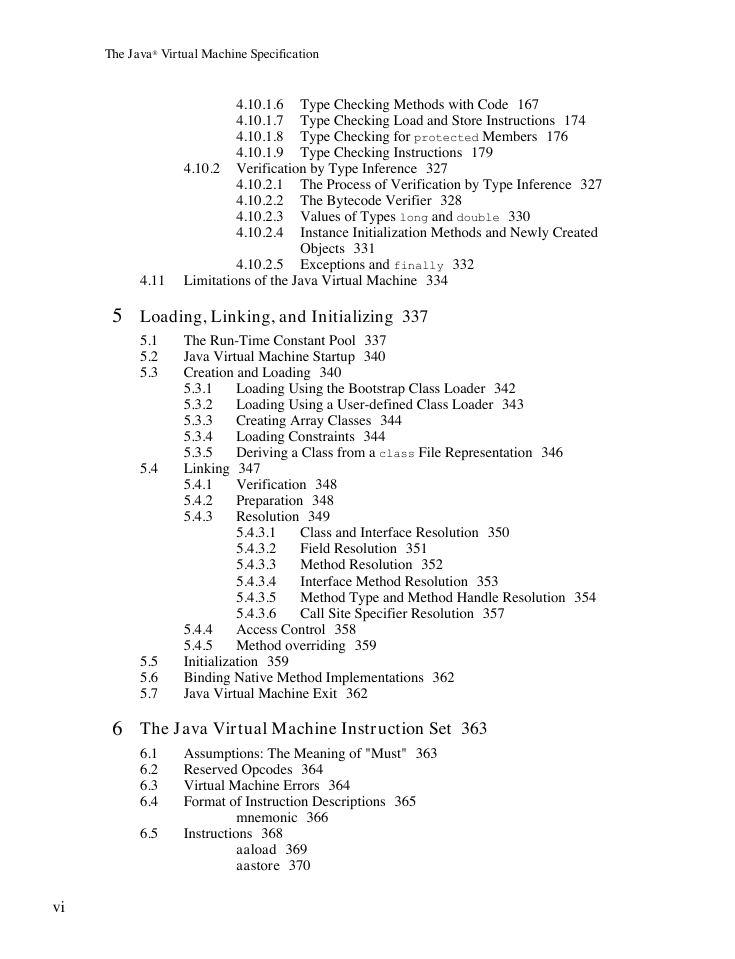
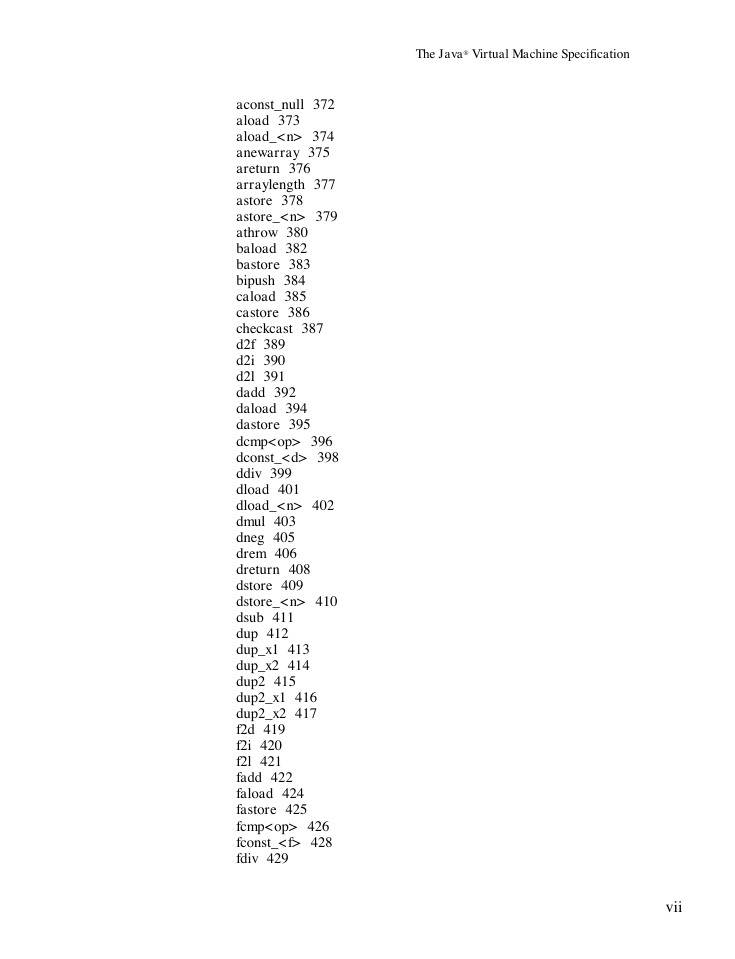
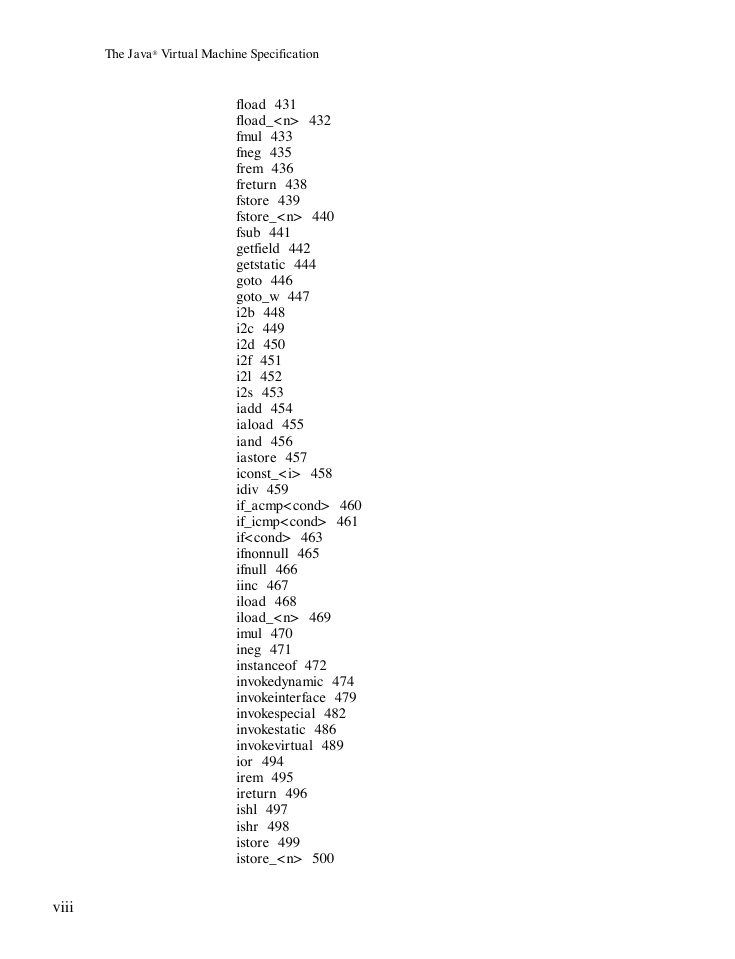








 2023年江西萍乡中考道德与法治真题及答案.doc
2023年江西萍乡中考道德与法治真题及答案.doc 2012年重庆南川中考生物真题及答案.doc
2012年重庆南川中考生物真题及答案.doc 2013年江西师范大学地理学综合及文艺理论基础考研真题.doc
2013年江西师范大学地理学综合及文艺理论基础考研真题.doc 2020年四川甘孜小升初语文真题及答案I卷.doc
2020年四川甘孜小升初语文真题及答案I卷.doc 2020年注册岩土工程师专业基础考试真题及答案.doc
2020年注册岩土工程师专业基础考试真题及答案.doc 2023-2024学年福建省厦门市九年级上学期数学月考试题及答案.doc
2023-2024学年福建省厦门市九年级上学期数学月考试题及答案.doc 2021-2022学年辽宁省沈阳市大东区九年级上学期语文期末试题及答案.doc
2021-2022学年辽宁省沈阳市大东区九年级上学期语文期末试题及答案.doc 2022-2023学年北京东城区初三第一学期物理期末试卷及答案.doc
2022-2023学年北京东城区初三第一学期物理期末试卷及答案.doc 2018上半年江西教师资格初中地理学科知识与教学能力真题及答案.doc
2018上半年江西教师资格初中地理学科知识与教学能力真题及答案.doc 2012年河北国家公务员申论考试真题及答案-省级.doc
2012年河北国家公务员申论考试真题及答案-省级.doc 2020-2021学年江苏省扬州市江都区邵樊片九年级上学期数学第一次质量检测试题及答案.doc
2020-2021学年江苏省扬州市江都区邵樊片九年级上学期数学第一次质量检测试题及答案.doc 2022下半年黑龙江教师资格证中学综合素质真题及答案.doc
2022下半年黑龙江教师资格证中学综合素质真题及答案.doc